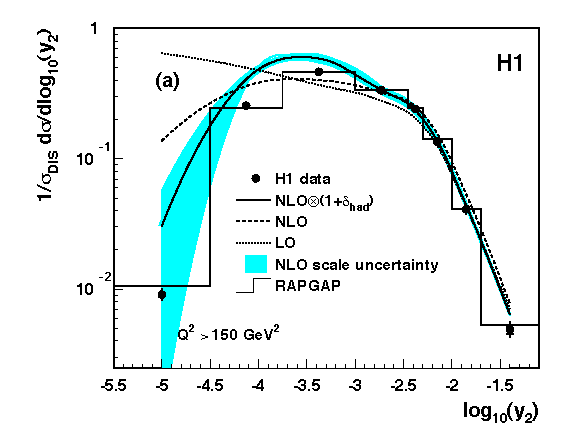Measurement of Dijet Electroproduction at Small Jet Separation
|
Much of the research performed at the electron-proton
collider HERA is directed towards a better understanding of the strong
force. While the much better known electrical force is responsible
for the interaction of electrically charged objects like electrons and
ions, the strong force determines the interaction of quark and gluons
- the constituents of nuclear matter.
Quarks and gluons are usually confined into hadronic objects like protons
or pions and are not directly observable as such. In the extremely violent
electron-proton collisions at HERA, however, quarks and gluons are accelerated
to the speed of light and become visible in the physicists' particle detectors
as jets of highly energetic hadronic particles. The electron and proton
collisions where (at least) two of these quark- and gluon-jets are detected
are particularly suited to study the strong interaction between quarks
and gluons.
The topological properties of such events have extensively been investigated
in the past for jet configurations where the (angular) distance between
the jets is large. One may wonder if this is the most likely topology.
It is not !
Events with small jet distance are by far more abundant. Here,
we select (predominantly) such events and measure various jet properties
precisely. The sample of jet events is nearly three times as large as the
typical sample with two jet at larger distance.
Why have such events not been studied earlier? It is because the most
rigorous theoretical predictions - QCD perturbation theory in next-to-leading
order - which correspond to the current best understanding of the strong
interaction, are expected to be most reliable for the rare topologies with
jets at large distances. It seems to make little sense to compare measurements
with a theory in a range where it may not be valid.
We do it nevertheless! To our surprise we find that the theory
performs very well far beyond the range in which it was tested previously.
The range of validity of the QCD calculations seems to be much larger than
anticipated!
While this may increase the confidence in the correctness of Quantum
Chromodynamics, the theory of the strong interaction, it also calls for
more refined higher-order calculations, which will make possible even more
complete tests of our understanding of the strong interaction.

|
| The figure shows the distribution of jet distance - expressed in the
variable y2 - in events with two jets. (Large jet distances
correspond to large y2 values.) The solid line, which corresponds
to the mentioned prediction, describes the data well up to y2
= 0.001. Thus the theory performs well in a range that is about three times
larger than known previously ! |
Last Update on 26/10/2001
